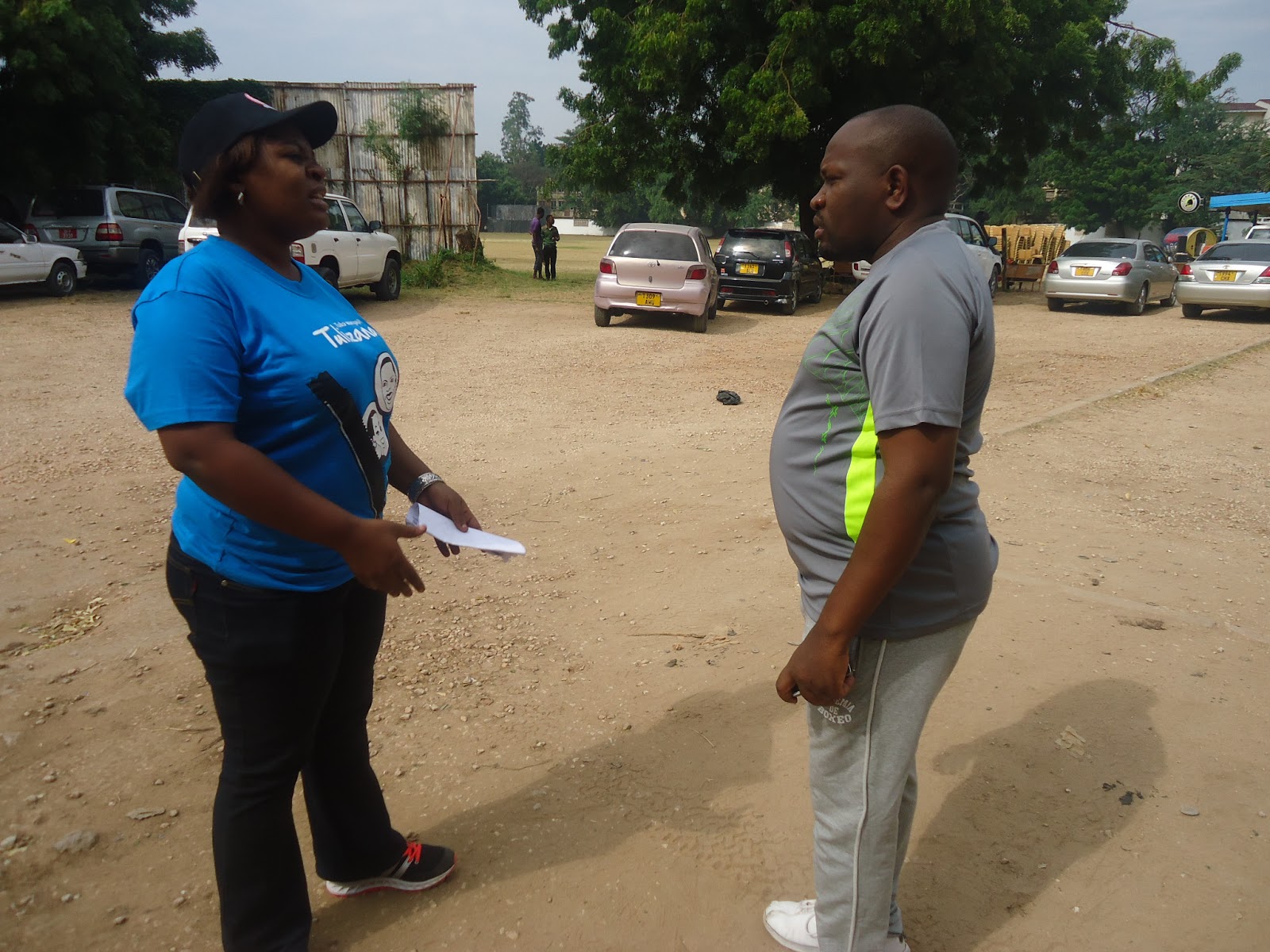 |
| Viongozi wa TACAIDS walipokutana na wahariri ofisini kwao |
Kwa mujibu wa TACAIDS, kupima UKIMWI ni mlango wa kwanza wa kufanya maamuzi sahihi ya kujikinga na maambukizo ya Virusi Vya UKIMWI (VVU) na kuanza kutumia dawa za kupunguza maambukizo kama mpimaji atagundulika keshaambukizwa.
Takwimu zifuatazo zinaonyesha wanawake na wanaume waliopima na kujua hali zao za Afya kwa kila mkoa. Hii ni kwa mujibu wa utafiti wa Taifa kuhusu UKIMWI na Malaria (THMIS) wa mwaka 2011/12
MKOA WANAWAKE WANAUME
Arusha 64 29
Dar es Salaam 72 55
Dodoma 63 42
Geita 50 35
Iringa 69 53
Kagera 66 44
Katavi 47 42
Kigoma 62 53
Kilimanjaro 64 52
Lindi 74 53
Mara 59 50
Morogoro 56 36
Manyara 56 41
Mbeya 54 42
Mtwara 71 50
Njombe 74 65
Pemba 55 36
Pwani 72 48
Ruvuma 69 51
Shinyanga 61 49
Singida 61 51
Tabora 70 52
Tanga 57 48
Unguja 61 52
Takwimu hizo zinabainisha jinsi wanaume wasivyokuwa wajasiri kupima VVU katika kila mkoa. Hii maana yake nini?
Wataalamu wa masuala ya UKIMWI wanasema, mbali na unyanyapaa unaouzunguka ugonjwa huu, lakini pia wanaume wengi husubiria majibu ya wake zao wanapokuwa kliniki ya ujauzito. “Majibu ya mkewe yakitoka negative basi nae (mme) hujitapa na kujifariji kuwa naye yuko negative” aliwahi kuniambia mwanaharakati mmoja.
Mkuu wa kitengo cha Sera na Mipango katika Tume ya UKIMWI Nchini Dk Raphael Kalinga yeye huwa ana sera yake: UKIMWI Unaanza na Mimi. UKIMWI ni Janga langu Binafsi!
Kwa mujibu wa Dk Kalinga, hadi pale kila mtu bila kujali ameoa au ameolewa atakapotambua kuwa UKIMWI ni janga lake binafsi na kuchukua hatua za kujilinda yeye binafsi changamoto za kuukabili ugonjwa huo zitaendelea kuwepo.
"Hebu tufike mahali kila mmoja wetu atambue ugonjwa huu ni janga lake binafsi," akasema Dk Kalinga na kuongeza, tumwachie Rais ndie asema UKIMWI ni janga la kitaifa...Mkuu wa Mkoa aseme UKIMWI ni janga la Mkoa wake...Mkuu wa Wilaya naye aseme UKIMWI ni janga la wilaya yake...hivo hivo hadi ngazi ya famailia na hatimae mtu binafsi"
Dk Kalinga anasema, katika kufanikiwa katika juhudi za kutatua tatizo la UKIMWI nchini, kimakati inabidi ijengwe kutoka kwa mtu binafsi kwani suala la msingi katika mapambano ya UKIMWI ni kubadili tabia miongoni ma wana jamii.
Kwa mujibu wa Dk Kalinga, sera iliyopita ilijikita katika programe za UKIMWI lakini katika sera mpya iliyofanyiwa marekebisho inaweka msisitizo wa programu hizo kujenga kwa mtazamo wa kwamba inabidi zianze kwa mtu binafsi.
Takwimu zifuatazo zinaonyesha wanawake na wanaume waliopima na kujua hali zao za Afya kwa kila mkoa. Hii ni kwa mujibu wa utafiti wa Taifa kuhusu UKIMWI na Malaria (THMIS) wa mwaka 2011/12
MKOA WANAWAKE WANAUME
Arusha 64 29
Dar es Salaam 72 55
Dodoma 63 42
Geita 50 35
Iringa 69 53
Kagera 66 44
Katavi 47 42
Kigoma 62 53
Kilimanjaro 64 52
Lindi 74 53
Mara 59 50
Morogoro 56 36
Manyara 56 41
Mbeya 54 42
Mtwara 71 50
Njombe 74 65
Pemba 55 36
Pwani 72 48
 |
| Dk Raphael Kalinga, Mkurugenzi wa Sera na Mipango, TACAIDS |
Shinyanga 61 49
Singida 61 51
Tabora 70 52
Tanga 57 48
Unguja 61 52
Takwimu hizo zinabainisha jinsi wanaume wasivyokuwa wajasiri kupima VVU katika kila mkoa. Hii maana yake nini?
Wataalamu wa masuala ya UKIMWI wanasema, mbali na unyanyapaa unaouzunguka ugonjwa huu, lakini pia wanaume wengi husubiria majibu ya wake zao wanapokuwa kliniki ya ujauzito. “Majibu ya mkewe yakitoka negative basi nae (mme) hujitapa na kujifariji kuwa naye yuko negative” aliwahi kuniambia mwanaharakati mmoja.
Mkuu wa kitengo cha Sera na Mipango katika Tume ya UKIMWI Nchini Dk Raphael Kalinga yeye huwa ana sera yake: UKIMWI Unaanza na Mimi. UKIMWI ni Janga langu Binafsi!
Kwa mujibu wa Dk Kalinga, hadi pale kila mtu bila kujali ameoa au ameolewa atakapotambua kuwa UKIMWI ni janga lake binafsi na kuchukua hatua za kujilinda yeye binafsi changamoto za kuukabili ugonjwa huo zitaendelea kuwepo.
"Hebu tufike mahali kila mmoja wetu atambue ugonjwa huu ni janga lake binafsi," akasema Dk Kalinga na kuongeza, tumwachie Rais ndie asema UKIMWI ni janga la kitaifa...Mkuu wa Mkoa aseme UKIMWI ni janga la Mkoa wake...Mkuu wa Wilaya naye aseme UKIMWI ni janga la wilaya yake...hivo hivo hadi ngazi ya famailia na hatimae mtu binafsi"
Dk Kalinga anasema, katika kufanikiwa katika juhudi za kutatua tatizo la UKIMWI nchini, kimakati inabidi ijengwe kutoka kwa mtu binafsi kwani suala la msingi katika mapambano ya UKIMWI ni kubadili tabia miongoni ma wana jamii.
Kwa mujibu wa Dk Kalinga, sera iliyopita ilijikita katika programe za UKIMWI lakini katika sera mpya iliyofanyiwa marekebisho inaweka msisitizo wa programu hizo kujenga kwa mtazamo wa kwamba inabidi zianze kwa mtu binafsi.







































































